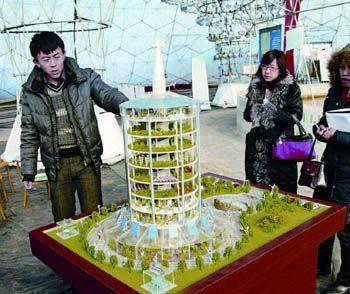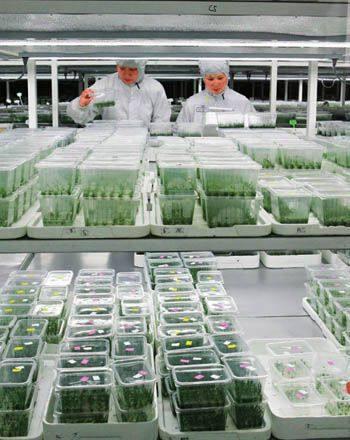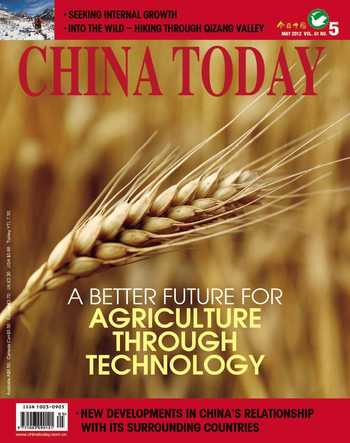Smart agriculture
ZHANG XUEYING

PULLING in RMB 40 million of revenue from a 14-hectare block of farmland – thats RMB 2.86 million per hectare – sounds nigh-on impossible in this age of stiff competition and slim margins. And yet in 2010, Beijing Futong Horticulture Co., Ltd. managed just such a feat. How did they do it?
“Its quite hard to earn decent profits by relying solely on traditional planting methods,”says Zhang Tianzhu, general manager of Futong Horticulture, affiliated with China Agricultural University. “Due to the high cost of land, labor and logistics in Beijing, strong profits are out of reach unless we get smart with our use of technology.”

Going Hi-Tech
Lucheng Town in Beijings Tongzhou District is about 30 minutes drive from downtown. Futong Horticulture maintains its headquarters southeast of the town at the sprawling Tongzhou International Metropolitan Agriculture Science and Technology Park.
China Todays visit to the complex is in early spring, a time when Beijings plant life is only just beginning to stir after the long, cold winter. Browsing the technology parks greenhouses, it was as if we had flown five hours south to the tropics. At every turn, the dense foliage of hydroponic plants burst forth in verdant splendor. Xing Lili, vice director of the park, boasts:“Every facility here contains the latest plant-growing technology – growers dont want to go back to their own fields after trying their luck here!”
Xing runs us through the technological marvels. He points to electric rotavators that automatically turn up soil and sow seeds. Generators increase carbon dioxide density, which helps photosynthesis and increase yields. “Nano water” technology increases waters oxygen content. One grafting machine, which manages 600 sprouts per hour, is not only four times faster than grafting by hand, but also increases sprouts survival rate to 96 percent.
Sound waves pumped into the greenhouses are adjusted to six different audio frequencies depending on prevailing light and temperature conditions. This accelerates plantsgrowth. “Maybe youve heard of playing music to cattle to soothe them, but here we play music to plants to stimulate their growth,” says Xing. His first experiment with “sound growth” was on a batch of strawberries last year. Compared with a control sample, playing “music” not only increased
yields by 10 percent, but the strawberries also tasted better, according to Xing.
All in all Futong Horticulture employs about 100 agricultural technologies on its plot, representing a swathe of breakthroughs from the last 10 years. In the future, Futong Horticulture plans to establish a coordinated production, research, marketing and training service for new technologies in conjunction with several renowned agricultural research institutions such as China Agricultural University and the Chinese Academy of Agricultural Sciences.
“Moving away from traditional agricultural parks that feature sightseeing, recreational areas and hobby picking, Chinas metropolitan agriculture centers need to get serious and streamline links in the chain linking agribusinesses, new technologies and parks such as the one in Tongzhou,” says Zhang Tianzhu.
Zhang has been at the cutting edge of Chinas agricultural development for many years now. He started out in agribusinesses in 1995, when he worked on local agricultural development plans and did occasional marketing projects for agriproducts. His years of work since have imbued him with extensive experience and unique insights into Chinas agriculture scene.
In Zhangs opinion, Chinas current system for realizing scientific innovation in agriculture needs improving. Government- led innovation efforts are not enough. Connections among government, scientific researchers and education establishments need to be beefed up, he says. At present, there are significant delays in bringing new technologies into the production process after they have been perfected. According to related calculations, the majority of new technologies dont even make it to farms – the domestic “conversion rate” of research to tangible results sits at a mere 40 percent.
“In explaining the benefits of agricultural science and technology to lay people, the best way is invite them to fields to see the tangible results,” says Zhang. “One of the reasons we established the science and technology park in Tongzhou is to showcase the technology. The plan worked, and we have succeeded in raising interest in hi-tech agriculture among governmental agencies and private agribusinesses alike.”
Brand Building
“In the past, science and technology parks were funded exclusively by government. Nowadays we are exploring new sources of funding, mostly public-private partnerships. Our goal is to create a model park for the capital or even the whole country,” says Li Wenzhou, who, as deputy chief of Lucheng Town, is in charge of local agriculture.
“Currently, we are in the process of creating a unique brand.” In 2011, Tongzhou district government organized the first Tongzhou International Agricultural Science and Technology Festival. “Although we didnt do a lot of publicity, to our surprise about 400 agriculture professionals, including agricultural counselors from foreign embassies, attended the opening ceremony. We now plan to hold the festival annually,” Li says.

“This year we are waiting for the unveiling of some fantastic new technologies. The market is strong, and growers are looking to take advantage of that.”
Investment interest in the Tongzhou park is also steeping up, he notes. “Since last year, an increasing number of companies have been plowing investments into the park. A domestic company has invested RMB 20 million, and at present we are negotiating with one French company and one Dutch company about possible future investments,” Zhang says.“Our park has become a true hub and a great platform for the mixing of new ideas, technologies and dreams. We are right at the cutting edge – China Agricultural University even plans to exhibit some of their very latest research projects at the park.”
Jia Xiaoming, board chairman of Zhongyinghe International Consulting Company, has visited the Tongzhou technology park several times, and is responsible for one of its most exciting up-and-coming projects.
“Our partners own a technology that uses glacier water in seed breeding. They have found that mineral water obtained from altitudes of 4,000 meters and above significantly raises yields in wheat cultivation and, remarkably, also renders crops more resistant to pests. After many experiments at the Ministry of Agriculture, we successfully obtained a national patent,” says Jia, who plans to invest RMB 10 million in the park to build a seedling cultivation center.
Zhang Tianzhu has some star projects of his own. He spent three years designing and developing, and now owns the patent on a “revolving greenhouse.” It is now at the experimental model stage.
According to his design, the greenhouse is large – 39 meters high, and boasts nine stories. The first floor will actually be a restaurant, and the space above it will be a growing area divided into several platforms. To satisfy the lighting requirements of plants, each growing platform will rotate slowly to receive the maximum amount of sunlight.
The greenhouse is a pollution-free project. Aside from only using various green sources of power, such as wind and solar energy and methane, all the waste produced from the greenhouse will be completely recyclable. Even the restaurants trash will be broken down into fertilizer for plants.
“The greenhouse will contain many of the latest scientific research achievements in agriculture, such as changeable ventilation, sunlight monitoring, temperature control and carbon dioxide supplementing. All these aspects mean construction will be a big task,” Zhang says. “But we are building for the future of metropolitan agricultural development.”
The revolving greenhouse concept not only provides high agricultural output and solves problems of food safety, but also doubles as a beautiful space that attracts nature lovers. “Agricultural tourism” has been catching on of late in many countries around the world.
Li Wenzhou is excited about Zhangs revolving greenhouse project.“If he finds himself short of funds, our local government can offer help. We hope his greenhouse will become a landmark symbol for our park.”
Zhang is already thinking beyond greenhouses to different urban spaces where agriculture can be developed.“There are many unused areas in cities, such as basements, discarded factories, and even roofs and balconies. These could all be transformed into productive agricultural workspaces.”Zhang and his team will make a trip to Norway and the Netherlands to immerse themselves in local agricultural mechanization techniques. Down the line he hopes to introduce technologies from those countries to the Tongzhou park. “Science and technology is the way forward to higher yields and bumper profits in agriculture,” says Zhang. The future of Chinas agricultural development seems to be in safe hands.

